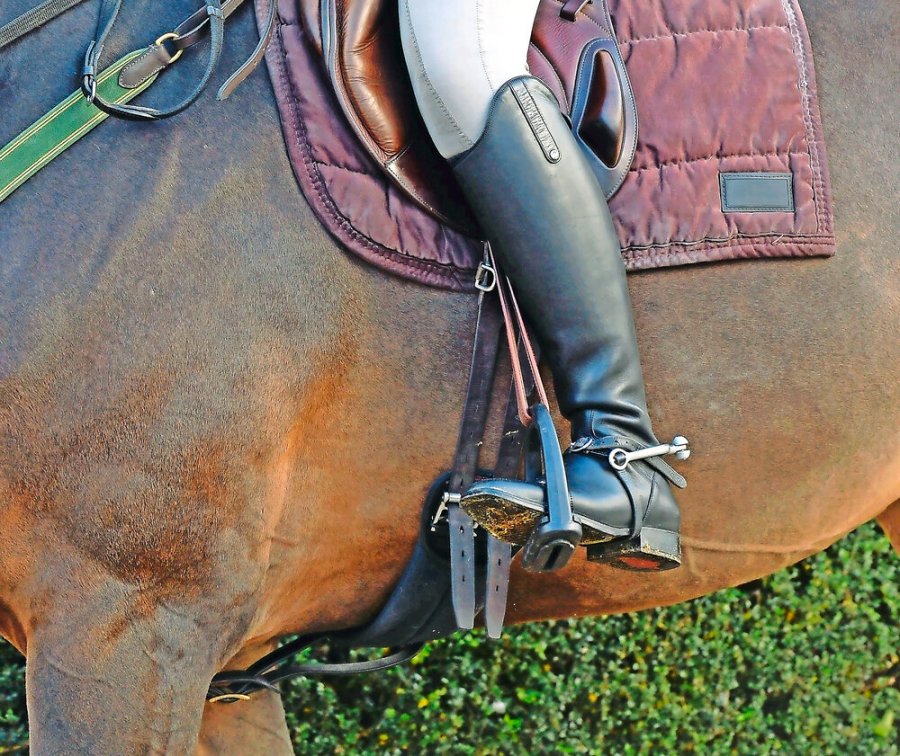In partnership with Wintec Saddles
How often do you think about the length of your stirrup leathers and the position of your irons? So often we mount up and ride away without giving them a second thought — because your ‘normal’ length doesn’t change, unless you’re going to be jumping or doing dressage. Whether you predominantly hack or school, riding with incorrect stirrups — perhaps they are too long, too short, or unlevel — could leave you unstable in the saddle and feeling sore. And when you’ve got 1,000 hacking miles to cover, you want to be riding and feeling your best.
Biomechanics trainer Hannah Irons says that she meets many riders who aren’t aware of the impact their stirrups have on their riding or position in the saddle, and it’s one of the first things she corrects in a session. It can make an immediate positive change to your comfort, position and effectiveness in the saddle.
“What I often see is riders with too long stirrups and they have to reach for them, so they hollow their back,” says Hannah. “Likewise, when the stirrups are too short, riders tend to round their backs.”
Whether you’re hacking around the block or heading out for long distances, riding with the wrong stirrup length can leave you with aches and pains.
“In the short term, you’ll have muscle fatigue from overworking some muscles and underworking others,” explains Hannah. “Typically, things like hollowing your back or sitting like you’re in a chair. It causes strain and discomfort, and we know it can work its way up to hunching shoulders and headaches.”
If you’ve been riding with the wrong length for a long time it can be a much tougher issue to address.
“We develop postural habits, which leads to longer-term pain complaints,” adds Hannah. “I think it’s quite hard to find a rider who doesn’t have a back pain issue.”
Finding the right length
There’s no definitive guide to finding the right stirrup length as it depends on your conformation and saddle, but Hannah says there are a few ways you can get started:
1. Stirrup to the armpit
- Hold the top of your stirrup leather where it joins to your saddle.
- Bring the stirrup leather along your arm and see where the stirrup iron reaches.
- The iron should reach your armpit.
2. Iron to your ankle
- Sit in the saddle without your stirrups and your legs hanging comfortably.
- The bottom of the stirrup tread should rest by your ankle bone.
“In an ideal world, you look at the angle of the hip and thigh too,” says Hannah. “A commonly used guide is the thigh bone being 40-45° to the ground. A good way to check this is to get a friend or instructor to take a photo so you can see if you are in balance.”
Hannah adds that there are variables, and these rough guides won’t work for everyone.
“If you are particularly long through the thigh or the lower leg then you’ll need to find a balance,” she says. “These guides are a good starting point. I would always recommend working with an instructor or biomechanics coach to get it right for you personally.”
Story continues below
You may also enjoy…
Three ways to avoid stiff ankles and aching hips when you’re riding
The problem with unlevel stirrups
Whether one leather has stretched or you’ve popped them on mismatched holes, stirrup leathers that are uneven can leave you insecure and uncomfortable — sometimes without you even realising it.
“It’s going to completely adjust your balance,” says Hannah. “If you’re longer on one side — typically the left from mounting — you’re going to be reaching for that one a bit more and it’s going to tip you that way, so you’ll have to strain to stabilise yourself.”
If your leather has stretched over time, you may not even notice the change as your body adapts to it — but your horse certainly will.
“If we’re wonky as the rider, we’re putting more weight to one side and we’re affecting the horse’s balance,” explains Hannah. “Your horse will end up with overdevelopment and underdevelopment of muscles and it will affect saddle fit too, which could result in it slipping.”
This can leave you vulnerable if your horse spooks, as you are less secure in the saddle. It’s worth checking the length of your leathers after every few rides to make sure they are still even.
Making adjustments
If you jump your horse and/or do dressage as well as hacking, of course you’ll have more than one stirrup length that you use — but chances are you use one more regularly than the others. Even so, checking your length is still right for you whatever discipline you are riding is in important.
If you think it’s time to make a change to your stirrup length, be careful not to get too carried away.
“If you put them down too much in one go then you’ll end up reaching for them,” explains Hannah. “Or if you put them up you may hollow your back.”
Hannah recommends changing them gradually and doing some quick stretches before you leave the yard for your hack to get your body prepared.
“Take your feet out of the stirrups and give them a nice stretch, do some circles with your feet and ankles, swing your legs back and forwards from your hips and just loosen everything up,” advises Hannah. “If you have a spooky horse or feel nervous, just take one foot out at a time.”
If you’re doing this, remember to be sensible and stay safe. Ask someone to hold your horse while you do it, for example, or do it while you’re in a fenced off area such as an arena.
Meet the expert: Hannah Irons is a biomechanics trainer, riding instructor and confidence coach. She is a Franklin Method Equestrian Level 1 Educator and BHS Stage 2 Foundation Coach, and teaches private lessons, clinics and mechanical horse lessons covering the Leicestershire, Northamptonshire, Warwickshire and surrounding areas.
This content is brought to you in partnership with Wintec Saddles, durable, comfortable, easy-care, weather-proof saddles for everyone.








